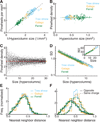Universality in the evolution of orientation columns in the visual cortex
- PMID: 21051599
- PMCID: PMC3138194
- DOI: 10.1126/science.1194869
Universality in the evolution of orientation columns in the visual cortex
Abstract
The brain's visual cortex processes information concerning form, pattern, and motion within functional maps that reflect the layout of neuronal circuits. We analyzed functional maps of orientation preference in the ferret, tree shrew, and galago--three species separated since the basal radiation of placental mammals more than 65 million years ago--and found a common organizing principle. A symmetry-based class of models for the self-organization of cortical networks predicts all essential features of the layout of these neuronal circuits, but only if suppressive long-range interactions dominate development. We show mathematically that orientation-selective long-range connectivity can mediate the required interactions. Our results suggest that self-organization has canalized the evolution of the neuronal circuitry underlying orientation preference maps into a single common design.
Figures




Comment in
-
Neuroscience. π = visual cortex.Science. 2010 Nov 19;330(6007):1059-60. doi: 10.1126/science.1198857. Science. 2010. PMID: 21097928 No abstract available.
-
Comment on "Universality in the evolution of orientation columns in the visual cortex".Science. 2012 Apr 27;336(6080):413; author reply 413. doi: 10.1126/science.1205737. Science. 2012. PMID: 22539703
References
-
- Hubel DH, Wiesel TN. Proc. R. Soc. London Ser. B Biol. Sci. 1977;198:1. - PubMed
-
- Blasdel GG, Salama G. Nature. 1986;321:579. - PubMed
-
- Bonhoeffer T, Grinvald A. Nature. 1991;353:429. - PubMed
-
- Ohki K, Chung S, Ch’ng YH, Kara P, Reid RC. Nature. 2005;433:597. - PubMed
-
- Ohki K, et al. Nature. 2006;442:925. - PubMed
Publication types
MeSH terms
Grants and funding
LinkOut - more resources
Full Text Sources
Molecular Biology Databases

